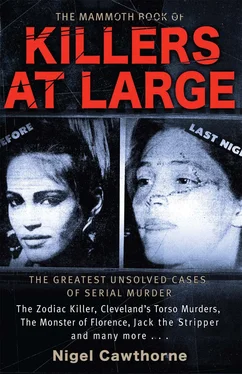“He threatened to kill me with it and to cut me into pieces unless I did as he asked,” Dorcas said the court. “He pushed me on the ground and took my panties off. He dropped his pants to his knees and he raped me.”
Then he engaged her in conversation.
“He told me he had a girlfriend in Vosloorus named Sibongile. He said he wanted me to go look for him at her home because she had stolen some things from him, but did not say what. He then asked if we could sleep together again.”
When Dorcas Khobane refused, he raped her again. Even then he was in no hurry to leave, but someone was coming and he fled. In court, Dorcas Khobane identified Moses Sithole as Samson, the man who raped her.
Again, in the dock, Sithole seemed amused, but he buried his head in his hands when Sibongile Nkosi took the stand. She was 17 years old in 1988 when she got involved with the 24-year-old Sithole, who then called himself Martin. Sibongile told the court that she had been afraid of him then and was still afraid now. He had often hit her and had threatened to kill her family if she left him. She said he beat her in private, then when someone visited he would put on a show of affection. Eben Jordaan suggested that his client would deny that he ever laid a finger on her. Sibongile Nkosi asked if she should strip naked so that the court could see the scars.
Sibongile’s younger sister Lindiwe Nkosi then testified that, in October 1988, “Martin” had invited her to visit her sister in Soweto. She was 15 at the time. On the way, they got off the train at Geldenhuis station. Luring her into the veldt he asked Lindiwe if she wanted to have sex with him. When she said no, he pulled out a bottle of petrol and said he would kill her and burn her body if she did not have sex with him. Then he beat her, raped her and throttled her until she lost consciousness. When she came round, he said he would kill her and her niece if she told anyone what had happened.
Although the rape of Buyiswa Doris Swakamisa had been dealt with in 1989, she appeared in the 1996 trial to testify about his modus operandi. Her presence in court reinforced the point that Sithole’s subsequent victims seem to have been selected for their resemblence to Buyiswa Swakamisa and explained why there had been no crimes between 1989 and 1993, when Sithole had been in prison for her rape.
Buyiswa Swakamisa testified that she had met a man calling himself “Lloyd Thomas” in February 1989. He offered her a computer job and said he would take her to his business. Walking through the veldt near Cleveland, he produced a panga from a rolled-up newspaper he was carrying under his arm and said he was going to have sex with her. Then in a dramatic gesture he “threw the panga to one side and said if I did not want to have intercourse with him, I could run away, but had to make sure that he did not catch up with me or he would kill me. I just stood there. He came towards me and slapped me and ordered me to take off my clothes. When I did not he slapped me twice with his open hand.”
In the event, he could not get an erection. So he forced her to kiss his neck and stick her fingers in his ears. And when he was ready, he raped her. Afterwards he was in the mood for conversation again. This time he said that “he hated women because he once had a child with a girlfriend in Alexandra and that his girlfriend had poisoned the child”. Then he tied her up, took her money and left. Once freed she went to the police, but nothing happened until, months later, she saw him in the street. She called the police and he was arrested. Only then did he give his name as Moses Sithole.
This was apartheid South Africa and Buyiswa Swakamisa was forced to travel to the police station in the police vehicle with her rapist. He cursed her and himself for not having killed her.
The most controversial charges levelled again Sithole were the murder of Amanda Thethe and the theft of her cash card. David Selepe been charged with her murder and pointing out where it had happened when he was killed. Amanda’s cash card had then been used to withdraw money from a cashpoint three times after she was dead. The man using it had been photographed by a security camera. Earlier the police had identified the man in this photograph as David Selepe. Now they charged Sithole with the robbery as well as her murder.
Four weeks into the trial Siphiwe Ngwenya took the stand. She had worked at Kids’ Haven with Tryphina Mogotsi and identified the man on the security camera photo as the man who had offered Tryphina a job when she went missing. This was Moses Sithole who, for once, was not using an alias.
Even more damning was the testimony of Kwazi Sithole, Moses’ sister. She also identified the man in the photograph as her brother. What’s more, she said that women often phoned her house about jobs her brother had offered them.
It then came to light that Sithole had known Amanda Thethe. When he had visited her father’s home some months before she went missing, she introduced him as her boyfriend “Selbie”. In early August, the prosecution contended, her boyfriend had raped her, stuffed her underwear into her mouth, tied her blouse around her neck and strangled her. Amanda’s aunt saw “Selbie” again. He attended her niece’s funeral. This is not uncommon among serial killers, who like to relive the moment of killing.
Amanda Thethe was not the only women Sithole had a relationship with before he killed her. Dan Mokwena, a work colleague of 19-year-old Elizabeth Mathetsa, had been sitting outside their workplace with her in early 1995 when a man walked up. Elizabeth introduced him as her boyfriend “Sello”. Dan Mokwena said that he saw Sello again a week before Elizabeth Mathetsa went missing on 25 May 1995. She was found dead in Rosslyn on 16 June. In court Dan identified the man he knew as “Sello” as the prisoner in the dock, Moses Sithole.
The aliases continued to multiply. Mary Mogotlhoa knew Sithole as “Charles”. They had had a brief relationship shortly before his arrest. It lasted only two weeks, but he had given her a watch, which Tryphina Mogotsi’s mother identified as her daughter’s. Mary Mogotlhoa also said that, after they had broken up, Sithole had gone to the police, told them that she had stolen 500 Rand (£35) and accused her of raping him.
Otherwise he repeatedly used the offer of a job as a bait. In March 1995, Wilhelmina Ramphisa met a man calling himself “David Ngobeni” who offered her a job. She completed in an application form he gave her, but he failed to turn up to their next appointment. Months later, she saw her potential employer again on the TV news. It was Moses Sithole and she had had a lucky escape.
A lorry driver named Piet Tsotsetsi testified that he received a number of calls on the phone in his lorry from women about jobs they said he had offered them. He was completely mystified by this. However, at the time, Sithole was working at the same company washing the vehicles. After he was arrested, the calls stopped. Elsie Masango’s sister testified that a man calling himself “Piet Tsotsetsi” had offered Elsie a job shortly before she disappeared.
Other witnesses testified, many of them parents who had to identify their raped and tormented daughters. No matter how harrowing the testimony, Sithole sat and smiled.
The only time he cried was when his wife Martha entered the court to testify against him with their one-year-old daughter Bridget asleep in her arms, but afterwards refused to let him see the child. This sudden upsurge of tears allowed those whose testimony he had sat through with a look of mild amusement on his face to laugh at him.
There was a brief respite when, on 12 November, the trial was suspended after Sithole had fallen down and re-opened his leg wound. When he returned from hospital, the grandmother of Monica Vilakazi testified that a man identifying himself as Moses Sithole had phoned her home on 11 September 1995, the day before her granddaughter went missing. He said they had met the previous month and had now found Monica a job in Germiston. The following day she left her grandmother’s house to become one of the women found at the Van Dyk Mine. Three days after Monica went missing, there was another phone call. This time the caller said his name was Jabulane, but Monica’s grandmother recognized his voice as Sithole’s. Before Monica’s funeral, the man phoned again this time identifying himself as “Mandla”. Sithole was in custody at the time and Mandla insisted that he would be acquitted. And he taunted the old woman, saying that Monica got what she deserved.
Читать дальше











